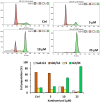Non-Volatile Terpenoids and Lipophilic Flavonoids from Achillea erba-rotta Subsp. moschata (Wulfen) I. Richardson
- PMID: 36679115
- PMCID: PMC9866263
- DOI: 10.3390/plants12020402
Non-Volatile Terpenoids and Lipophilic Flavonoids from Achillea erba-rotta Subsp. moschata (Wulfen) I. Richardson
Abstract
Musk yarrow (Achillea erba-rotta subsp. moschata (Wulfen) I. Richardson) is endemic to the Central Alps, and is used to flavour alcoholic beverages. Despite its popularity as aromatizing agent and its alleged beneficial effects on digestion, the phytochemical profile of the plant is still largely unknown and undiscovered. As a consequence, its authentication in aromatized products is impossible beyond sensory analysis allowing forgery. To address these issues, we phytochemically characterized a sample of musk yarrow from the Italian Eastern Alps, identifying, in addition to widespread phytochemicals (taraxasterol, apigenin), the guaianolides 3, 8, 9; the seco-caryophyllane 6; and the polymethoxylated lipophilic flavonoids 1, 4, and 5. The flavonoid xanthomicrol 1, a major constituent of the plant, was cytotoxic to HeLa cells, but only modestly affected primary 3T3 fibroblasts. On account of their stability, detectability by UV absorption, and concentration, the oxygenated flavonoids qualify as markers to validate the supply chain of the plant growers to consumers.
Keywords: Achillea erba-rotta subsp. moschata; guaianolides; lipophilic flavonoids; xanthomicrol.
Conflict of interest statement
The authors declare no conflict of interest.
Figures





References
-
- Richardson I.B.K. Achillea L. In: Tutin T.G., Heywood V.H., Burges N.A., Moore D.M., Valentine D.H., Walters S.M., Webb D.A., editors. Flora Europaea. Volume 4. Cambridge University Press; Cambridge, UK: 1976. pp. 160–161.
-
- Pignatti S., Guarino S., La Rosa M. La Flora d’Italia & Flora Digitale. 2nd ed. Volume 3. Edagricole; Bologna, Italy: 2018. Achillea moschata ; p. 836.
-
- Vitalini S., Madeo M., Tava A., Iriti M., Vallone L., Avato P., Cocuzza C.E., Simonetti P., Argentieri M.P. Chemical profile, antioxidant and antibacterial activities of Achillea moschata Wulfen, an endemic species from the Alps. Molecules. 2016;21:830. doi: 10.3390/molecules21070830. - DOI - PMC - PubMed
Grants and funding
LinkOut - more resources
Full Text Sources
Research Materials

